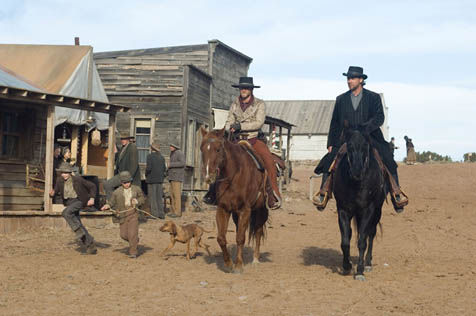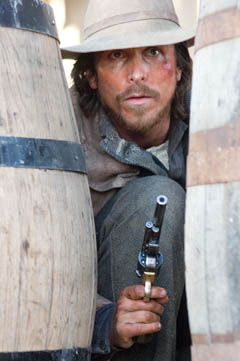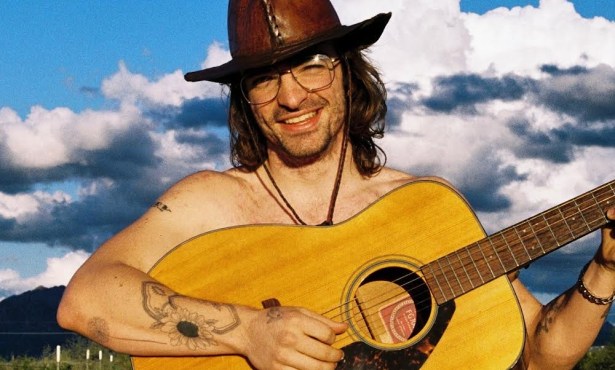James Mangold Updates the American Western with 3:10 to Yuma
The New Old West

After Walk the Line, his crowd-pleasing and critically acclaimed biopic of Johnny Cash, director James Mangold resurrects the Western with a remake of 1957’s 3:10 to Yuma. Starring Academy Award-winner Russell Crowe as a train-robbing outlaw and Christian Bale as the rancher who’ll deliver him to justice, the film proves a deep character study of good, evil, and in between, set against a backdrop of the gutsy and grimy Old West. I recently sat down with James Mangold to discuss his film.
Your 1997 film Cop Land was inspired by the original 1957 movie 3:10 to Yuma. What is it about this story that has gripped you all these years? Sometimes you can’t explain the effect certain movies have on you when you see them. There is a kind of brilliance to the story structure of the original, about the claustrophobia of the third act in a hotel room. A lot of interesting stuff for me.
You made some significant changes to the original movie. You expanded the journey in the middle of it. It seemed, to me, [that was] always a missing part of the story. And it seemed to me that it would even heighten the sense of claustrophobia in the third act if you had some sense of this traveling. I think we also had a lot of ideas that we wanted to bring to it-like the idea of following the transcontinental railroad as it’s being built, and the journey from Bisbee to Contention being a kind of journey of a land that’s untouched by too much corporate influence or the type of oncoming “progress” of America. Contention, being the place where it’s already reached, would serve as a kind of counterpoint to Ben Wade’s [Russell Crowe] evil. Ben Wade may be the last savage outlaw, but there’s another kind of shadow coming, which is a different kind of outlaw. Outlaw banks, outlaw corporations; the kind of dominance of the America we know.
You also expanded the role of the son, and he’s fascinated by the bad guy instead of his own father, who is a good guy. I was intrigued by the way the antihero is so incredibly fascinating to young people. Then making a movie in which you actually have a father, a kind of compromised normal figure, like most of us living life by the rules and getting screwed half the time and struggling. And then you have this kind of Superman that enters the scene and the father has to watch his son stare at this guy, no matter how violent he is, with a kind of awe. And I thought that was something really timely. I mean, I guess it’s something that is always timely and interesting to investigate.
Unforgiven is the exception, but most Westerns lately have been commenting on the genre. Yours doesn’t. That was very much on our minds. I’ve never been into the kind of movie about making a movie. And so one of the things I tried to put in my head was how would I go about creating a process for myself where I’m referencing the characters themselves, the setting, and the place-and not other movies. I never watched DVDs of Westerns while we were shooting. Why? You got Russell Crowe and you got Christian Bale and they’re acting their asses off. Shoot them. You know, like instead of quoting this or that shot in past Westerns. Just shoot it. And in a way that’s what occurred to me that Eastwood and a lot of the other great directors of Westerns did, which was they were never quoting anything. They were just making the damn movie.

You make us question our morality in this film. We find ourselves rooting for a very evil character in the lead. If you were a movie architect, you’d open up this movie and say, “I don’t think Russell is really the bad guy in this movie.” If you’re looking at the architecture of the movie, it’s kind of a buddy film, with these two guys. And if anyone’s the heavy, it’s the bank, the railroad, civilization. Those are the opposing forces. But it’s a very interesting point. I mean, Crowe is pretty much a hardcore sociopath in the movie but there’s also no doubt that he’s really likeable. I think about Jonathan Demme’s movie The Silence of the Lambs, which invites an audience into somebody who’s acting in ways that we can never act.
I know this is purely coincidental, but you have two iconic American characters, and they’re being played by a Brit and an Australian. That’s purely coincidence, right? Or is it a comment about American actors not being masculine? Well, I guess it could be. I mean, I think we just hired the two very best guys for the job. But when you really sit down to make a movie like this and you start analyzing the short list of actors who can pull it off : many of these guys working today would look like slouch-shouldered Malibu dudes on a horse. As an audience you’re just gonna go, “I don’t buy it.” They could be great in Spandex flying around Manhattan, but I don’t buy them on a horse. And so there’s just a level where it suddenly becomes a very short list of people.
4•1•1
James Mangold’s 3:10 to Yuma opens in Santa Barbara theaters this weekend.



